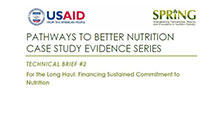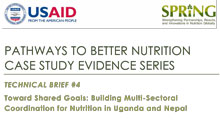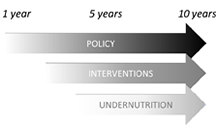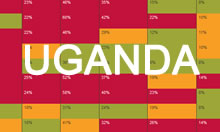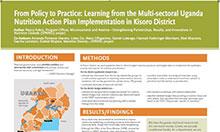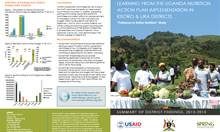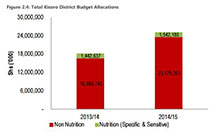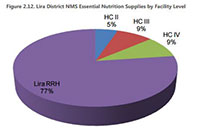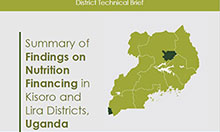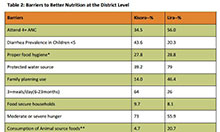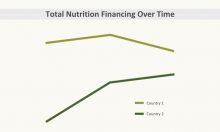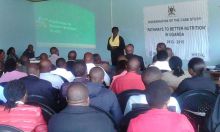The Uganda Nutrition Action Plan 2011–2016 (UNAP) provides a unique opportunity to understand how nutrition policy is translated into action. SPRING’s two-year (2014-2016) Pathways to Better Nutrition case study draws on qualitative and quantitative data to provide a 360-degree view of the Uganda Nutrition Action Plan (UNAP) process, including the policy, enabling processes and drivers, prioritization, and funding for nutrition described below.
Findings
SPRING found that the UNAP has played an important role in increasing knowledge, perceptions, and behaviors related to planning and financing for nutrition.
Click on the boxes below to read results for each category: policy, drivers, prioritization, and funding.
Understanding the UNAP
A first step in implementing the UNAP was to make sure it was understood and used by all nutrition stakeholders in Uganda. This included not just an understanding of the purpose and content of the UNAP, but also of each stakeholder groups' roles and responsibilities for supporting the policy. In addition, it was important for the UNAP to expand or increase knowledge of nutrition to a more multi-sectoral, nutrition-sensitive definition.
Understanding: At the start of our study, the majority of respondents (with the exception of a few private-sector stakeholders and ministry staff newly appointed at the time of the interview) understood the objective(s) in the UNAP that they could help achieve. Many also recognized the importance of having the sectors integrate the UNAP into their regular planning processes.
In both Kisoro and Lira districts, government stakeholders showed a general understanding of nutrition that appeared to increase between the first and second district data collection rounds. Overall, the UNAP was understood as a strategic policy document intended to help the district nutrition coordination committees (DNCCs) in Kisoro and Lira address undernutrition.
Concept of Multi-sectoral Nutrition: Even in the early days of the study, there was overwhelming agreement across national groups on the importance of nutrition, which spread over the study time period to cover nearly every stakeholder in every group. Some of those who said they had a positive change in perception of nutrition within their own sector specifically credited the UNAP for this change. As for the concept of multi-sectoral nutrition, many stakeholders in various ministries (as well as some EDPs) appeared skeptical or confused about how multi-sectoral nutrition would work at the beginning of the study, but by the endline, the majority of sectors spoke more positively of the concept and how they were contributing.
Now everybody seems to appreciate that nutrition is multi-sectoral problem, it requires to respond calling for the different actors and from what I have seen so far every sector is playing its own role.
– National government stakeholder.
In Kisoro and Lira, there was general understanding of the nutrition situation, but some local government stakeholders, CSOs, and development partners who we interviewed during the second round of data collection still believed nutrition to be a primarily health-related issue.
Roles and Responsibilities: Both national and district stakeholders—particularly those representing the sector ministries and local governments, private sector, and CSOs—were less sure of what the UNAP meant for planning and implementation, and how their roles were defined. Indeed, throughout the study, it was often mentioned that while UNAP provided good overall explanation of what each sector and district could address, they did not always know how to operationalize the suggestions.
It is unclear what the implementation strategy is and how we can best support it. When we are considering activities from UNAP we just identify the listed activities that we can contribute to based on our existing plans.
– National donor stakeholder.
For government stakeholders, the release of a planning document to accompany the UNAP could resolve this particular issue. The National Nutrition Planning Guidelines for Uganda (National Planning Authority 2015) gives comprehensive directions for both sector ministries and local government bodies to plan nutrition activities aligned with the UNAP, as well as Uganda Vision 2040 and the Sustainable Development Goals. This document may offer a more practical understanding of what the UNAP means for planning and implementation.
Taken together, this evidence points to widespread improvement in understanding of the UNAP, and a positive shift in perceptions about multi-sectoral nutrition actions. Knowledge of roles and responsibilities for all stakeholder groups will need to continue to improve, which may be supported by the new planning guidelines.
Drivers of Change
Figure 8. Drivers of Change for Nutrition in Uganda
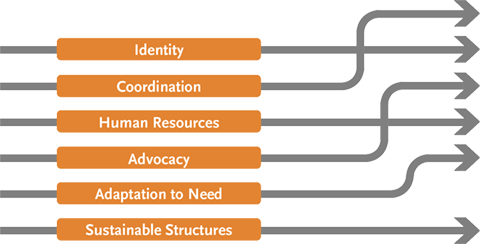
Certain actions, or "drivers of change," help or hinder the influence of the UNAP on nutrition prioritization and funding. In our qualitative data analysis, we considered reasons given for why the priority and funding of nutrition did or did not improve over time, as well as responses to specific questions about what challenges or enablers stakeholders faced in their efforts to conduct their nutrition activities.
From these data, we identified a set of drivers that were most critical to prioritizing and funding nutrition in this context. In this section, we describe the weight of evidence for changes in each driver that were a result of the UNAP. Figure 8 summarizes the drivers and the direction of change we found for each.
While this list is not exhaustive, it highlights the primary enablers and barriers that effected stakeholders' ability or desire to increase the priority and funds allocated to nutrition activities.
Identity
A clear identity for nutrition is critical to unify support for this cause. Unlike human immunodeficiency virus (HIV) or malaria, which are singular diseases with clear consequences, malnutrition comes in many forms and its effects are varied and sometimes subtle or delayed. This means champions need to find ways to define and "sell" nutrition as a critical and urgent need.
Multi-sectoral Coordination of Nutrition Activities
Coordination of nutrition planning, funding, and implementation across sectors, stakeholders, and government levels was also identified as critical to the scaling up of nutrition. This is a "soft" driver in that there may not be concrete signs of change, but changes in behaviors and perceptions as a result of coordination make a large difference when it comes to what is prioritized and funded.
Human Resources
Another important driver of change in how nutrition is prioritized and funded are human resources for nutrition. Human resources include all people involved in nutrition, including clinical and community providers, and clinical, policy management, and support staff at every level in every stakeholder group.
Advocacy for Nutrition
Advocacy for nutrition and UNAP is critical for convincing governments and EDPs to prioritize and allocate funds for nutrition.
Adaptation of the UNAP to Local Needs
For UNAP to have maximum impact, it must be tailored to each district's context prior to implementation. Because there is a wide variety in each district's needs and contexts, policymakers and program planners must understand and adapt to districts and sub-district administrative structures, and district and sub-districts will need to convey their needs, strengths, and barriers accurately.
Sustainable Structures
To maintain momentum, structures and processes for planning, funding, implementing, and monitoring nutrition activities must be in place. UNAP stakeholders have an important role in the difficult task of embedding nutrition into existing local and national policy and work planning structures, budgeting processes, and monitoring and evaluation (M&E) systems for the sustainability of commitment to nutrition.
Our evidence suggests that UNAP has had the most effect in improving coordination, advocacy, and adaptation to local needs. Details are provided below.
The UNAP's Influence on Drivers of Change
Unified Identity
Creation of a unified "identity" for nutrition emerged as a necessary driver of change, but we did not find notable improvements among stakeholders for this driver. An identity for nutrition began to be developed prior to the study, during UNAP launch. At the baseline and continuing throughout the study period, many government and nongovernment stakeholders mentioned the lack of a singular identity for nutrition in Uganda. They said it was a barrier to more concerted efforts for nutrition, both at the community-level—where it hinders partner buy-in—as well as at the national level, where it hinders awareness and advocacy.
One positive structural change in this area was the initiation of discussions within the Ministry of Health (MoH) to promote the nutrition unit to a division. This would help overcome the issue of segmentation of nutrition into smaller, less identifiable programs managed and advocated for separately by the nutrition unit, the reproductive health division, and the AIDS Control Program. Throughout the study, the National Planning Authority (NPA) and OPM maintained efforts to define nutrition as a unified issue at the national policy level, though it doesn't appear that the intensity of these efforts increased during the study period.
According to interviews conducted in 2013, lack of a unified identity complicated coordination and reduced the ability of several ministries to advocate for larger blocks of nutrition funding. Aside from improvements seen in MoH, by the end of the study there was still lack of a cohesive identity for how that ministry or sector was advancing the nutrition agenda. There are many multi-sectoral issues that demand resources in Uganda, which some stakeholders noted made it difficult for decision makers to prioritize nutrition.
The multi-sectoral approach—there are so many of them going around on different topics so there is competition for time.
– National UN stakeholder.
Some stakeholders suggested ways to learn from other efforts to build identity.
Learn from AIDS…The strategy required each sector in the framework to develop their own, and we did well!
– National government stakeholder.
When AIDS came, guidelines were given to encourage the business to develop a workplace policy.
– National private sector stakeholder.
During the first and second rounds of district data collection, the DNCCs and implementers mentioned the importance of eliciting a sense of urgency to motivate community members to adopt healthier behaviors. One person in the second round of data collection likened nutrition to the peace process, suggesting that it may be helpful to convey the importance of the issue by defining its consequences.
I think by talking about it, that the way we talk about peace, we tell them if you don't resolve this dispute, it will blow.
– District government stakeholder.
Multi-sectoral Coordination of Nutrition Activities
We found significant improvement in multi-sectoral coordination of nutrition and UNAP activities in the latter half of the study, primarily in stakeholder behavior and implementation of new work to improve coordination.
At the beginning of the study, more than two-thirds of stakeholder groups seemed to understand UNAP as a theoretical framework only. There was also concern through the first year of the study on whether OPM was the most appropriate body to lead the coordination. But we recorded a shift in perceptions of the UNAP coordination structures, particularly among donor and UN groups, starting in the spring of 2015 through the end of data collection. This led to increased participation in the multi-sectoral coordination structure by donor and UN groups, and an increased inter-sectoral coordination within nearly all ministries, which they credited to the UNAP structure. (Due to limited data, we were unable to assess changes in coordination within the private sector and academia.) Specific examples from KIIs and news article analysis of improved coordination during the course of the study follow:
- The official UNAP working groups became more active with regular coordination meetings and there was greater participation of different sectors during the meetings.
- OPM's launched the National Partnership Forum in December 2014, which, while not specific to nutrition, supports alignment of donor and government priorities.
- Ministry of Trade Industry and Cooperatives (MTIC) coordinated with the World Food Programme to increase engagement by the sector on nutrition issues, noting UNAP's influence on this outcome.
- European Union (EU) was in the planning stages of providing monetary support for UNAP coordination structures.
- External partners were in discussions for the UCCO-SUN coalition for 3 more years.
In an area as complex as multi-sectoral coordination, there is always room for improvement. One of the barriers that remains is the need to better engage academia. We noted that other stakeholder groups rarely mentioned the influence of academia in relation to their coordination activities. While the few who spoke about academia acknowledged that they were well-positioned to provide research and an evaluation of UNAP activities—as well as technical advice to OPM—we found no active nutrition projects or activities directly linked to UNAP in which academia was engaged. However, there are a few examples of joint academic-government research studies that could contribute to UNAP outcomes (e.g., Mwesigye and Bangirana 2015; Kawuma 2014; Agaba 2014).
We also noted the lack of engagement of the private sector in coordination activities during the course of the study. Interviews at the national and district levels suggested that private-sector organizations and associations were interested in engagement but unaware of coordination activities. The private-sector stakeholders would like more specific implementation guidance and clear arguments for the added value of new nutrition activities. Our review of local Ugandan news provided several examples of public-private partnerships for better nutrition, but they appear to be running outside the UNAP system (e.g., dairy cooperatives supplying schools, private fund drives for nutrition education in a few districts (Tibyangye 2014; Ragtrader 2015). The National Working Group on Food Fortification, led by the MoH, has also convened government, donor, UN, private sector, academia, and CSO partners to move forward on implementing the national mandatory fortification regulation. More effort is needed to link the private sector with government coordination structures—not just at the secretariat level, but in each sector. USAID and the United Nations International Children's Emergency Fund (UNICEF), the two biggest donors to nutrition in Uganda, began efforts to encourage public-private partnerships in 2014. This could be be a way to engage the private sector through the donor coordination platform. In addition, at the end of the study, there were questions from both national- and district-level stakeholders about how to improve vertical coordination between national ministries and districts.
Human Resources
When discussing challenges to prioritizing and funding nutrition in Uganda, stakeholders across sectors and groups said that to achieve UNAP goals human resources must be enhanced. This call for greater support did not change over the course of the study. Human resources for nutrition concerns coalesced around three topics: availability, capacity, and turnover of existing staff.
Availability and over-commitment of staff:
Of course one of the most major challenges is that the staffing norms at the local government level, the number of commitments that [they] have to deal with, are a big challenge.
– National UN stakeholder.
Stakeholders called for additional nutritionists and nutrition technical staff at the following levels and for the following tasks:
- within ministries for planning and prioritizing projects
- within facilities to conduct nutrition-specific activities
- in districts and communities to advocate, plan, and implement nutrition-sensitive activities.
In some cases, particularly in sectors that do not traditionally provide nutrition services, one of the barriers to availability was that leadership did not recognize the need to hire nutrition-trained staff.
[A challenge] is each and every service delivery has to have a specialist but we don't have them in all. Let's also look at the education centres—they can be a good point for nutritionists to be involved but we lack specialists to give right information.
– District government stakeholder.
The capacity of additional human resources for nutrition was another issue.
There is need to build capacity of clinical and health workers since most of them are not trained in nutrition and nutrition interventions or treatment. They need to be trained or oriented in case identification and referral.
– District government stakeholder.
We did hear some positive change in this area, such as the development of a short course by academic stakeholders on nutrition for public health professionals, and district training and support, led by OPM, which was often cited as a positive outcome of UNAP. However the effect of these efforts on nutrition programming seemed minimal. Some DNCC members and staff still did not believe they had the breadth of technical nutrition knowledge to implement the UNAP, despite being oriented to their roles. This was also the case in sector ministries that were newer to the UNAP structure. Nearly all sector ministries noted at least once during the study that financial constraints limited what they could do to address human resource capacity.
Finally, among UNAP focal positions, we found regular turnover of staff in key positions, sometimes leading to extended vacancies. Of the seven UNAP national focal positions that we followed through the study, three saw at least one turnover during the two years, and two were vacant at the time of the endline.
Level and Depth of Advocacy for Nutrition
I think one of the most important changes is that people are positive about nutrition; they recognize the importance of nutrition. We see it getting higher on the national agenda.
– National UN stakeholder
Placement of the UNAP secretariat within the OPM initially signaled high-level government leadership. There has been continued improvement in this driver over the course of the study, coming from many behavioral and structural changes.
There was a shift in the prominence of nutrition as reflected in the National Development Plan (NDP) II (2015–16 and 2019–20). Advocacy efforts organized by OPM, NPA, and CSOs pushed nutrition to a higher priority in the NDP II than in the previous NDP. At the district level, we also heard that—at least within the health sector—staff have advocated to have nutrition included in the next district development plans. At the national ministry level and within CSOs, there appeared to be growing advocacy efforts to include nutrition into major projects, plans, and campaigns. CSO stakeholders in particular emphasized their role in advocating to leaders and political figures at the district and below to develop local-level champions for nutrition.
Although occurring after the end of the official data collection for this study, a major development for advocacy was the launch of the Nutrition Advocacy and Communication Strategy by OPM at the sixth Africa Day for Food and Nutrition Security event. At the launch, the Prime Minister said, "As a country, through the Nutrition Advocacy and Communication Strategy, we shall cultivate awareness approaches to proper nutrition as required by the constitution." (SPRING project 2015). This strategy addressed calls for guidance at both sector- and local-levels on how to better advocate for nutrition in the planning process. Other positive changes included the following actions:
- CSOs urged the GoU to increase attention on child development issues (including nutrition) in developing the national plan to meet the Sustainable Development Goals.
- The Ministry of Gender, Labour and Social Development (MoGLSD) successfully lobbied Parliament for a line-item in 2015 to support children. The majority of the funding will go to feeding.
- The anemia working group within the MoH advocated for nutrition across the ministry.
These efforts will need to continue and intensify to result in greater gains in prioritization and funding. Some stakeholders suggested that advocacy is most needed within the MoFPED because of the potential gains in nutrition status that could result from improved funding for wide-reaching nutrition-sensitive activities. A potential barrier was the limited spread of champions into the public realm: the only new or continuing champions noted in the interviews were individuals within the ministries who may not be as well-known outside their own sector, but who were convincing more people to support nutrition.
Adaptation of the UNAP to Local Needs
The study found moderate improvements (primarily behavioral change and implementation) in developing local capacity to assess nutrition needs, and in helping local stakeholders use this information during work planning to incorporate nutrition and adapt the UNAP guidance to their needs.
Although district stakeholders in Kisoro and Lira were not specifically asked about situation analyses, it came up that USAID's Community Connector project had supported an exercise like this in Kisoro and five other districts in 2012 and 2013. Beyond Lira and Kisoro, other districts may be moving toward improvements in assessing local nutrition needs.
I can't speak to all of the districts… But yes, at least they have made a stride that [some] have done better situational analysis of nutrition and food security status... I can confidently say that I have seen a change. And over the next five years I think we will see even more of a change.
– National UN stakeholder.
The purpose of such exercises is to ensure that current needs and gaps in coverage are identified.4 In both Kisoro and Lira districts, some gains were described between the first and second rounds of data collection—government officials were able to collect, review, and use nutrition indicators for planning—but sub-county government still faced challenges in this area.
We have already [village health teams], we have [community development officers] and are working with the health units in those areas; they lack the feeling of understanding how to interpret UNAP indicators.
– Kisoro district government stakeholder.
How many districts in the country have partners that can support nutrition? You may find that just a handful. So those districts that can, can start. Those districts that can have their plan, including nutrition, should be able to kick start. But the problem is how much of it can be done [without funding].
– National government stakeholder
There were positive changes in building the capacity of local level stakeholders to use this information for nutrition work planning. In interviews conducted during the first year of the study, OPM, the Ministry of Education, Science, Technology and Sport (MoESTS), MoGLSD, and MoH were all said to have new projects in partnership with various donor and UN groups that supported capacity development for planning and implementation of nutrition-related activities at the district level. By the end of the study, there was increased national awareness and acknowledgement of the financial barriers that districts face when implementing nutrition across government sectors and donors. The National Nutrition Planning Guidelines for Uganda (National Planning Authority 2015) also provided the first concrete guidance to districts and below on how to assess and plan for nutrition activities. This greater capacity for work planning allows districts to tailor national funding and priorities to local barriers and solutions.
In both Lira and Kisoro districts, we heard that OPM had trained and engaged the DNCCs, but that more work is needed to develop a true system of feedback for planning and reporting. The DNCCs were, in turn, working to engage sub-county nutrition coordination committees (SNCCs) and parishes in their planning processes by the second round of district data collection. They said this was necessary to take into account the needs of the community. However, DNCCs in these two districts mentioned that even when they were aware of local needs, they were not necessarily able address them since the conditionality of national-level grants did not provide the flexibility to develop and implement targeted programs.
Sustainable Structures
When you look at the approach of the UNAP, it's really the way to go for sustainability where the structure is within government, there people who are dedicated to support the coordination of the nutrition interventions with all these structures within the sectors and local government levels. Once those structures are in place, that's the first step to sustainability.
– National UN stakeholder
Although our analysis found some positive changes (primarily related to planning), overall the evidence does not suggest major changes in this driver. One seemingly significant perception change was that by the endline, several donors and UN representatives had changed their opinion of what constitutes government buy-in for nutrition activities—they no longer thought political will for nutrition was enough. They thought that GoU also had to show commitment with resources (some mentioned human resources, others infrastructure, but many meant financial resources).
Planning Structures
Several positive changes in the planning structures of ministries and districts may improve the priority of nutrition. As mentioned in previous sections, just after the study period, NPA released nutrition planning guidance. Other tangible improvements include the following actions:
- OPM continued efforts to embed donors into the UNAP structure and the UNAP into donor work planning.
- The Ministry of Agriculture, Animal Industry and Fisheries (MAAIF) and MTIC was considering formal inclusion of nutrition in sector plans.
Most of this change represented nascent movement rather than full-fledged change in structures. We heard from most ministries at the time of the endline that there were still no clear ministry-wide rules or protocols in place for how to plan for nutrition. Going forward, it will be important to see that the new nutrition planning guidance is institutionalized into each nutrition-related ministry's work planning cycle.
At the local government level, the nutrition planning structures (DNCCs and SNCCs) in both Kisoro and Lira were up and running by the end of the study. At the time of the follow up, Kisoro had also rolled out the multi-sectoral working group to the parish level with the formation of community mobilization teams (CMTs). These structures are meant to guide nutrition activity planning, implementation, and monitoring. We could not assess whether this had the intended effect of improving the priority of nutrition in these two districts.
Financial Structures
While some tentative steps to embed nutrition financing into government structures were taken during the course of the study period, stakeholders noted little actual change. OPM did recommend including nutrition in ministry budgets in the same way that gender or climate change (and cross-cutting issues) are, but according to our evidence, these changes were not undertaken.
At various points across the study period several government stakeholders mentioned that it would be advantageous to have a dedicated budget item for nutrition.
People have urged that we do not need special funding for nutrition, just make it an issue during your own normal work but my experience is that when you don't tag funds to something, it does not become an issue.
– District government stakeholder.
This feeling was echoed by stakeholders who thought the line-item should run through each ministry. They felt that without designation, nutrition activities will not get funded, even if they are planned.
There are additional barriers to sustainable financing that go beyond nutrition and affect all funding in Uganda. Among other areas noted in Pomeroy-Stevens et al. 2015, these barriers relate to:
- Financial transparency and tracking systems. Since the start of the study, GoU has made strides to build routine financial tracking systems for off-budget funding (MoFPED and Development Gateway 2014) and for maternal, newborn, and child health (Nassaka 2015). However, off-budget financial tracking continued to be an issue; we heard from MoFPED at the end of 2014 that off-budget reporting by EDPs was not mandatory. MoFPED was able to track 98 percent of on-budget EDP investments. Also, by the end of the study there was no formal system to track nutrition-related funding. Regarding transparency, we heard from a selection of government stakeholders that volatility of the cash budget and excessive use of supplementary budget requests destabilized the implementation of planned activities, making it hard to track what projects were in fact receiving funds each year.
- Absorptive capacity of financial systems. There were several news stories about low spending of both government and donor nutrition-related allocations (Emorut 2015; Civil Society Budget Advocacy Group 2014; Wandera 2015). Donor, UN, CSO, and ministry stakeholders confirmed these reports, providing examples of specific projects that did not spend their full allocation in 2013–14 or 2014–15. They cited either late release of funds or procurement delays as the primary causes. However, a news story in July 2015 noted that MOFPED had improved overall absorption capacity in ministries, agencies, and departments from 23 percent to 50 percent (Oketch 2015b).
- Leakage in financial systems. Leakage is an issue in nearly every country, and Uganda is no exception. An August 2015 news story noted that according to the World Bank, Uganda loses approximately USD 258.6 million (about UGX 853.4 billion) every year through procurement malpractices and corruption (Kayiwa 2015). To combat this, GoU launched the New Public Finance and Accountability Act in 2015, which mandated termination of employment for any finance officer who is found misusing funds.
Monitoring and Evaluation Structures
For me the next phase of UNAP should focus on monitoring the performance, the progress that when we put situations in place to monitor progress, they will swing us into action, to do specific activities.
– National government stakeholder.
Little change to M&E structures was seen. At endline, we heard from many government stakeholder groups that there was an unmet need for guidance on UNAP monitoring and evaluation. At the same time, KIs from the MoH and MoESTS noted interministry efforts to include new or updated nutrition indicators into reporting systems, but we heard of no unified efforts across all nutrition-related sectors. Several ministry stakeholders called for guidance on how to go about this. OPM, with support from development partners, did develop the UNAP M&E framework in 2015, but it was still awaiting final approval in early 2016. In Kisoro and Lira, we heard in the 2014 and 2015 budget validation interviews that the Output-based Budgeting Tool did not include any nutrition indicators, which many stakeholders noted was a hindrance to budgeting for nutrition at the district level.
According to data collected through this study, these six key drivers of change affect how and why nutrition is prioritized and funded. The next two sections describe the shifts found in nutrition prioritization and funding.
Prioritization
Prioritization is the process of deciding which topics, programs, or activities are most important. Within any organization, prioritization helps administrators determine what will, and will not, be programmed and funded. The level of priority that nutrition receives relative to all other interests determines whether nutrition will receive any attention, and if so, if that attention and corresponding funding will be adequate.
We looked for the following evidence to determine the extent to which nutrition was prioritized by each sector and stakeholder group within a given sector:
- Inclusion of nutrition as a named priority in the sector's strategy documents (or organizational strategy and investment documents for EDPs).
- Creation of a nutrition and/or food security unit, division, or department, or addition of a major nutrition initiative or program.
- Creation of, or increased leadership role in, a nutrition review process within a sector.
- Explicit discussion of or planning for nutrition that would imminently result in one of the above.
Table 1 summarizes the prioritization changes we found. We also noted the status of nutrition in each government sector strategy by the end of the study.
Table 1. Change in Priority of Nutrition, by Sector (direction of arrows indicates change, color of arrow indicates relative level of priority by endline)
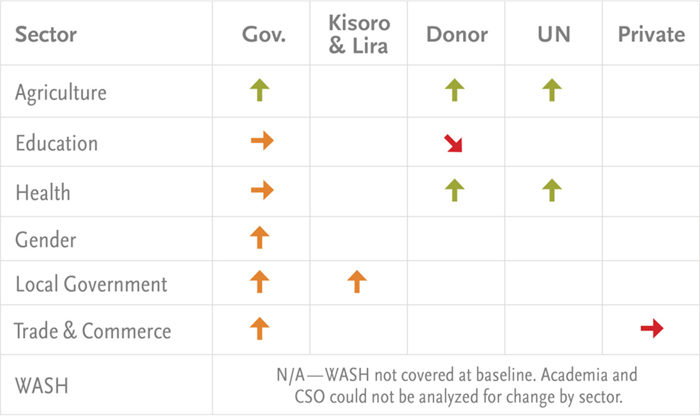
*EDPs work in multiple sectors, but for this analysis they were categorized into those for which they explicitly discussed their involvement in the work planning process. This means responses from some EDPs (such as USAID and the World Bank) are included in the group analysis for multiple sectors.
** WASH sector government and EDPs did not have sufficient longitudinal data to detect change.
Some groups, such as the MoH and UNICEF, identified nutrition as a high priority at the start of this study. Therefore, even though we did not see major change over time, they were continuing on a positive trajectory. While others did not identify nutrition as a priority for their group at the beginning of the study, responses from KIIs conducted toward the end of this study indicate improvements in prioritization for four of the seven ministries, including increased discussions of nutrition in sector planning meetings; spread of the UNAP usage beyond the focal person; and increased understanding and advocacy for nutrition by the planning offices. The 2015 planning guidance also includes some specific direction on where in the process more explicit planning for nutrition can be inserted, though it is yet to be seen how these are implemented (National Planning Authority 2015).
That said, even at the end of the study most ministries reported planning based on their development strategy and investment plans (DSIPs), which did not name nutrition as a priority. However, three ministries (MAAIF, MoH and MTIC) took steps in 2015 to explore doing so.
[Leadership] are spearheading the whole of nutrition seeing how the Development Strategy and Investment Plan (DSIP) can integrate nutrition. So I have seen a deliberate move […]and I believe that the next [agriculture] DSIP coming will have direct nutrition initiatives.
– National government stakeholder.
Several donors, UN groups, and private-sector respondents still said they primarily followed internal planning and policy documents for funding decisions. The intention was to use the UNAP to update internal policies/strategies, but given the five-year life of many of these policies, it had not happened for most EDPs. Overall, most EDPs did note their activities were funded and planned in cooperation with the GoU, so national priorities were always considered (Nandudu 2015). However, by the end of the study, only one donor noted that the UNAP was in the top tier of national plans they consult when planning nutrition activities.
Within the EDPs allied to each sector, there was a generally positive view of how ministries were now discussing nutrition, although some mentioned they wanted to see greater government buy-in on key nutrition issues.
As we think of the UNAP II, I think clarity in ministries' planning on nutrition issues and location of resources is going to be key because the amount of resources that is going to come from projects and so on is very minimal. So there has to be… planning for specific interventions on nutrition.
– National donor stakeholder.
The last two years of the UNAP have been around either developing strategic documents to allow their operationalization of the UNAP… in terms of the actual implementation in the district, I must say that is a little bit limited.
– National UN stakeholder
We found relatively little evidence of implementation of new nutrition projects explicitly developed to support UNAP activities, or of existing projects that have increased alignment with the UNAP. While a handful of new nutrition activities were implemented in most sectors during the time period of the study, we did not hear in our qualitative interviews or in our budget validation interviews that any were influenced or added to support the UNAP. If stakeholders were able to give a reason for why these were being implemented, it was usually because of existing EDP priorities, non-UNAP government plans or priorities, or requests by districts (which may or may not be because of the UNAP).
In Kisoro and Lira, there was a modest increase in nutrition activities between the first and second rounds of interviews. By the second round, both districts were implementing nutrition promotion and community empowerment activities; they rolled out ready-to-use therapeutic food at the lower health centers for treating acute malnutrition, directly influenced by the DNCC. Both districts developed a five-year costed district nutrition action plan (DNAP) with support from the USAID Food and Nutrition Technical Assistance Project (FANTA), although the DNAP was still waiting for funding for implementation at the end of 2015.
In sum, we saw positive changes in perception and behavior during the study period that led to more KIs in four of the seven sectors stating that nutrition was a priority. There appears to be a move toward inclusion of nutrition in several DSIPs, although, as of the end of the study, nutrition had not yet become a named priority for any sector. We found relatively little evidence of those priorities being put into action with the implementation of new nutrition projects. The next and final section of our findings describes funding totals and any changes seen in allocations and expenditures for nutrition.
Funding
Our aim in whatever we do should be towards getting increasing funding to implement nutrition-related interventions. If the nutrition policy is the way to go that might get us to funds. So be it. But let us aim at finding ways of funding nutrition. With or without nutrition policy, it can happen but if the government sees that as a step towards increasing funding, that's the way to go.
– National UN stakeholder.
After a new nutrition project is approved in a work plan, ministries and EDPs must ensure that funds are allocated. After allocation, funds must be released to each sector and sent to lower government, and these allocations must be spent (spending is otherwise known as expenditure). For each step, bottlenecks may reduce or even eliminate financial support for a given activity.
The on-budget process for government ministries in Uganda is consultative and decentralized, and EDPs who fund via the MPS largely budget within the government calendar and structure. Until 2015, planning and budgeting at the local level began in October and was finalized at the national level in June (Muwonge et al. 2011). This has recently been revised so that planning ends in April (Muhumuza 2015a, see a mapping of the budget process). Each sector has a financial officer who helps the process advance. As one of these officers said, aside from checks on the figures to meet stated sector priorities and budget ceilings, they "accept the budget as [sectors] have given them to us." Therefore, the prioritization phase is the best time to influence whether or not nutrition activities are funded. However, negotiation during budgeting can influence the amount of funding attached.
Off-budget activities—those planned by EDPs (donors, UN groups, CSOs, or even the private sector) outside the government budget structure—are supposed to be coordinated with MoFPED. The relevant sector ministry is supposed to design and implement the activity, but this is not mandatory; the process is primarily the responsibility of the EDP. Off-budget planning and budgeting may or may not align with the GoU budget calendar, and may in fact follow the fiscal calendar of the donor, UN group, or other EDP. As noted previously, there is less transparency in reporting those allocations and expenditures to GoU (both MoFPED and sector ministries). The recent launch of the Aid Management Portal should improve this reporting, but at the end of 2015, actual commitments and disbursements had not been included in the database for most projects (MoFPED and Development Gateway 2014). Our data for off-budget EDP funding were sourced from paper reports. This lack of timely data makes it difficult for related ministries to incorporate this information into their work planning and budget planning.
In this section, we report estimates of both on- and off-budget nutrition allocations and expenditures as well as the explanatory qualitative data.
Allocations
Figure 9 shows the total (on-budget and off-budget) allocations for the two years of data that could be validated during this study. Combined allocations for nutrition in 2014-15, using all available sources and adjusted for inflation to 2015-16 figures, totaled 472 billion Ugandan shillings (UGX) (USD 140 million.5
Figure 9. Total On- (Government and EDP) and Off-Budget (all other EDP) Allocations for Nutrition, 2013-14 — 2015-16
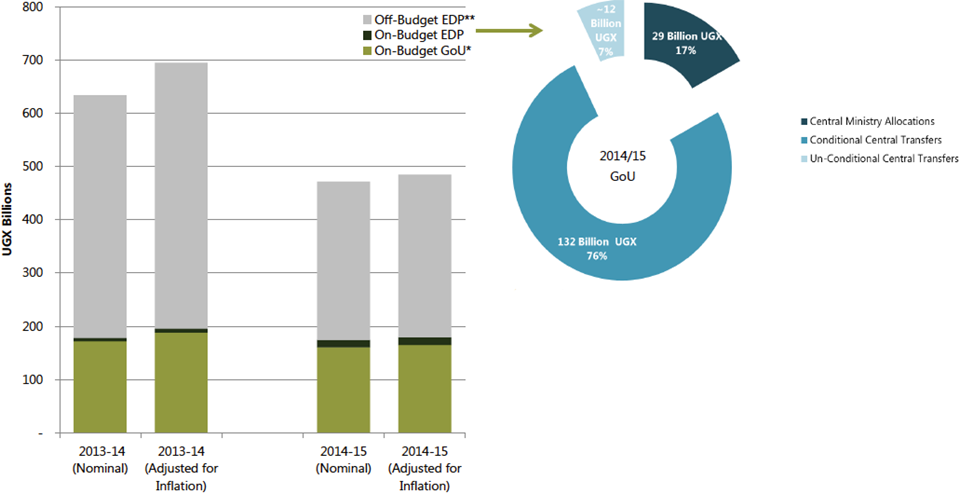
Adjusted figures are all in 2015–16 currency.
*GoU includes central transfers to districts.
**Off-budget EDP funding was last publicly reported in 2013, so projected 2014–15 figures may not include projects added after that last round of reporting.
On-budget (dark green segments) allocations stayed relatively flat between each year. After adjusting for inflation, there was a real decrease of around eight percent.
GoU (light green segments) funds made up about 35 percent of all nutrition allocations over time, but it is important to note that this amount will vary depending on how much of the MoLG transfers to districts count toward nutrition—these transfers make up 83 percent of all GoU nutrition-related funds (see lighter blue segments of inset pie chart).6 National ministry allocations (dark blue segment of pie) totaled about 29 UGX billion in both years once adjusted for inflation.
Off-budget funding (grey segment) also decreased between 2013–14 and 2014–15 (from about 450 to 300 UGX billion). Because the last publicly reported off-budget data only projected figures for 2014–15, this may not include projects added more recently. However, we did not hear of any new projects for 2014–15 in our validation interviews.
Figure 10. 2014–15 On- (Government and EDP) Budget Allocation for Nutrition, by Sector
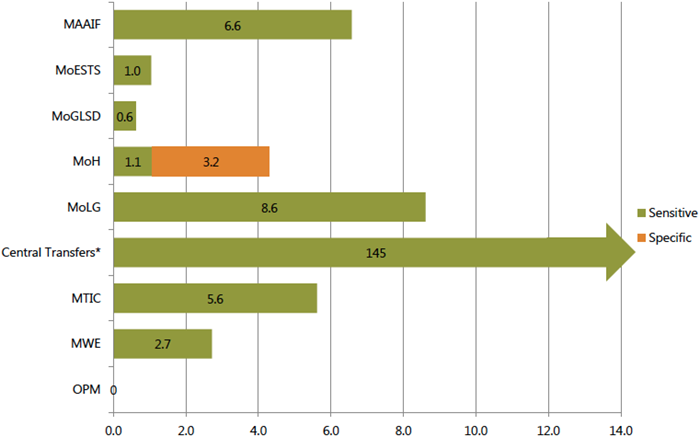
*Nutrition activities categorized as specific if they included one of the 10 Lancet nutrition-specific interventions. All other UNAP activities were considered nutrition sensitive.
Central transfers to the districts were by far the largest contributor to total national GoU and on-budget allocations. In our detailed analysis of allocations in Kisoro and Lira, we found total district-level nutrition-related allocations for 2013–14 and 2014–15 were UGX 2.6 billion and UGX 1.6 billion, respectively in Kisoro; and UGX 5.3 billion and UGX 4 billion, respectively in Lira (Lukwago et al. 2016a; Lukwago et al. 2016a). On-budget allocations made up just under two-thirds of total allocations in both years. Off-budget EDP funding (run through local NGOs) contributed the remaining funding. Conditional central transfers supplied about 70 percent of the on-budget totals, while unconditional (or discretionary) transfers contributed an additional 21 percent in Kisoro and 6 percent in Lira.
The challenge … is that the budget that we have as a district is funded by the [national] government. And up to 96 percent of [national] government budget are conditional grants. They come for specific departments, to do specific things and even if you see that there are pressing needs in this department and the grants are not that department, then your eyes are on and hands off.
– District government stakeholder.
The decrease seen over the two years in both districts was associated with the suspension of the National Agricultural Advisory Services (NAADS) funding, as well as a drop in reporting of budget information by NMS and donors for off-budget funding in 2014–15. The elimination of NAADS also explained the overall drop in central transfers at the national level (from 151 billion to 145 UGX billion).
In 2014–15, the MoLG was the ministry with the highest allocations for nutrition, even when central transfers were split out. All of this was allocated to strengthening local service delivery and development. Allocations for this line-item increased 185 percent between 2013–14 and 2014–15, despite cuts in GoU funding of nearly 100 million UGX during this time. The increase was entirely funded by the International Fund for Agriculture Development (IFAD), which provided 8.5 billion UGX in 2014–15. Both GoU and IFAD funding for this project appear to end in 2015–16.
MAAIF followed next with 6.6 billion UGX, but MAAIF also saw the largest decrease in funding between 2013–14 and 2014–15. Nutrition-related MAAIF allocation decreased from approximately 13 billion UGX in 2013–14 to just less than 7 billion UGX in 2014–15. Adjusted for inflation, this represents a decrease of funding of nearly 50 percent. Three of the 14 nutrition-related programs ended in 2013–14, contributing to this decrease. In addition, there was a significant decrease in funding for the labor-saving technologies and mechanization for agricultural production enhancement project. MTIC provided the third-highest allocation for nutrition; allocations stayed relatively flat between 2013–14 and 2014–15. Nutrition-related projects primarily addressed value addition to fruit and vegetable production.
While the MoH's allocations for nutrition was not as high as others', they were the only allocations for nutrition-specific projects (orange bar)— all but one (Uganda Sanitation Fund Project) of the five MoH nutrition-related programs were nutrition-specific. Nutrition-related allocations made by the MoH increased by about 50 percent between the first and second year of this study, primarily due to a doubling of EDP funds for the Global Fund for AIDS, TB and Malaria program, and new funding from the GoU and the UN for the Uganda Sanitation Fund Project.
Often, advocacy groups will refer to the percentage of total ministry allocation as a benchmark for support to nutrition and other sub-sector priority areas. Table 2 provides these percentages for both years. No major patterns emerge, reflecting the somewhat unpredictable allocations for nutrition during this time. Among ministries, MTIC, MoLG, and MAAIF appear to have devoted a greater percentage of their total allocations to nutrition-related activities each year.
Table 2. 2014–15 Nutrition Allocations as a Percent of Total Ministry Allocation
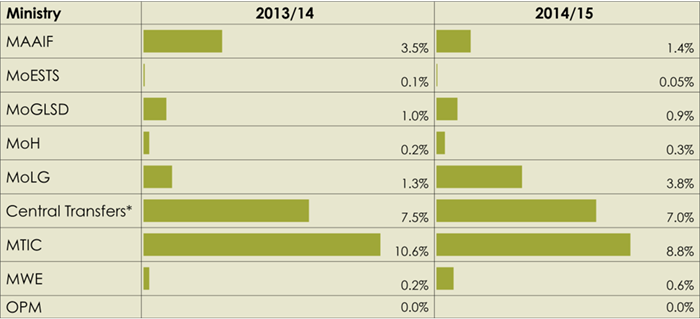
For off-budget allocations, health contributed the most nutrition-related funding by far in both years; 311 and 175 billion UGX in 2013–14 and 2014–15, respectively. For 2014–15, this represents nearly two-thirds of total off-budget nutrition-related allocations. Approximately 26 percent of that total was for nutrition-specific activities (details provided in annex 5). USAID is the primary contributor to nutrition-related health funds, followed by UNICEF, United Nations Population Fund, and European donors such as IrishAid and Sweden. However, as one national government stakeholder noted after the end of data collection, "there is more than meets the eye" when it comes to off-budget funding. One example given was that sector ministries often supply human resources to off-budget EDP activities, effectively providing a cost-share on many activities. Because this labor is very hard to track, it is not reflected in the budget numbers presented.
As a final note on allocations, we explored the balance of funding by UNAP objective area (figure 11). This information can be used for planning purposes to ensure ministries and EDPs are aligning the priority activities with the UNAP. Overall, allocations for each objective area exceeded the projected cost for each year. For the last year we tracked, the UNAP projected that 42 UGX billion would be needed (around 50 UGX billion when adjusted for inflation). Comparing this to the 472 UGX billion allocated, there appears to be no gap in funding for UNAP.
Figure 11. On-Budget Ministry Allocation by UNAP Objective Areas
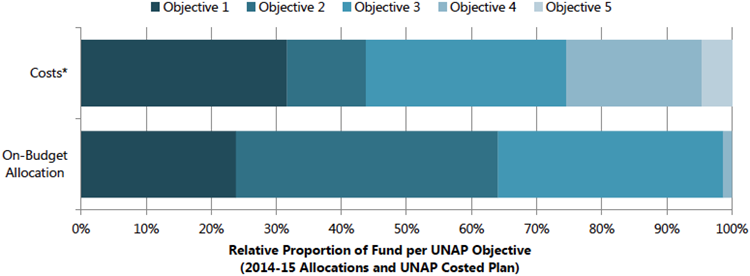
*Source for projected costs: Government of Uganda (2011)
However, this does not mean that allocations by UNAP objective area match the cost projections. Objective 2 was allocated nearly triple the amount projected in the costed plan. Conversely, for Objective 4, allocations were a much smaller percentage (or emphasis) than the amount included the costed plan. Objective 5 received no allocations despite an estimated cost of nearly 2 billion UGX.
UNAP Objective Areas
Objective 1: Improve access to and utilization of services related to maternal, infant, and young child nutrition.
Objective 2: Enhance consumption of diverse diets, which comprehensively address food availability, access, use, and sustainability for improved nutrition.
Objective 3: Protect households from the impact of shocks and other vulnerabilities that affect their nutritional status.
Objective 4: Strengthen the policy, legal, and institutional frameworks; and the capacity to effectively plan, implement, monitor, and evaluate nutrition programs.
Objective 5: Create awareness of and maintain national interests in and commitment to improving and supporting nutrition programs in the country.
Source: Ugandan Nutrition Action Plan (GoU, 2011)
When asked why or how they determined amounts allocated, a few KIs from donor and government stakeholders in the agriculture and gender sector mentioned advocacy to increase funding for nutrition activities, but these were not explicit UNAP activities. Also, donors and OPM have advocated for a nutrition line-item, but such a line-item was not included in any of the fiscal years examined.
Nonetheless, our findings indicate that allocations for nutrition were sufficient (as compared to the costed plan) and do not show any growth between years but rely heavily on off-budget EDP funding for some nutrition-related activities in the health sector. We saw no growth in nutrition-related allocations over the two years studied, and central transfers made up the majority of on-budget GoU funds.
Expenditures
As mentioned earlier, we did not have access to expenditure data for off-budget funding. Neither could we locate any publicly available data on 2014–15 expenditures for central transfers. As such, we present and discuss only changes in expenditures for on-budget national ministry funding (figure 12).
Figure 12. Total On-Budget (Government and EDP) National Ministry Allocations and Expenditure for Nutrition, 2013–14 and 2014–15
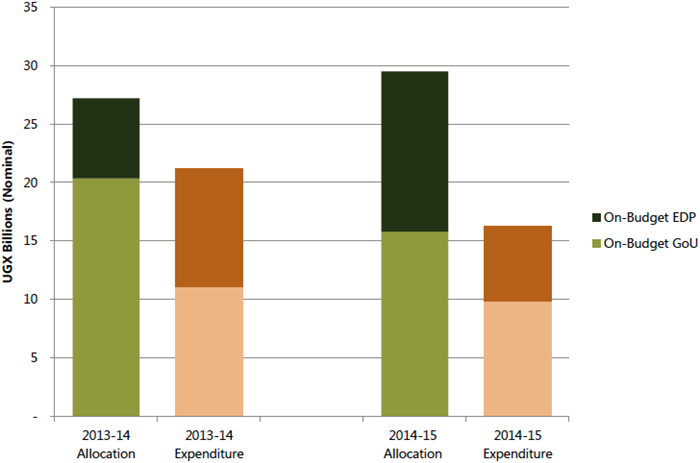
For the two years examined, average nutrition-related yearly GoU expenditures (lighter segments) were around 50-60 percent of the total amount allocated. EDP spending varied greatly and was heavily influenced by a large overspend of the health systems strengthening program in the MoH: it was overspent by 698 percent in 2013–14 and 472 percent in 2014–15. Without that program included, EDP spending for 2013–14 would have been closer to 80 percent, and dropped to 25 percent in 2014–15. A breakdown of all ministry spending appears in table 3.
Table 3. Expenditure of Nutrition-Related On-Budget (GoU and EDP) Allocations
| 2013–14 | External % | GoU % | 2014–15 | External % | GoU % |
|---|---|---|---|---|---|
| MAAIF | 105 | 24 | MAAIF | 59 | 38 |
| MoESTS | N/A | 80 | MoESTS | N/A | 54 |
| MoGLSD | N/A | 81 | MoGLSD | N/A | 46 |
| MoH | 341 | 65 | MoH | 150 | 40 |
| MoLG | 63 | 30 | MoLG | 0 | 24 |
| Central transfers | N/A | 66 | Central transfers* | No data | No data |
| MTIC | N/A | 97 | MTIC | N/A | 88 |
| MWE | 101 | 106 | MWE | 123 | 72 |
| Avg. national expenditure rate for nutrition allocations | 152% | 69% | Avg. national expenditure rate for nutrition allocations | 83% | 52% |
*No expenditure data for this year.
Nutrition-related funding in MoESTS, MoGLSD, MTIC, and all central transfers were entirely GoU funded for these years. Within GoU funds in 2014–15, expenditure rates varied from 24 percent for MoLG to 88 percent for MTIC. External funding for nutrition appears to be overspent for MoH (as previously noted) and MWE, while being fairly underspent for MAAIF and MoLG, at least in 2014–15.
Our interviews and news content analysis indicated two primary reasons for under-spending of on-budget funds in these two fiscal years:
- Delayed release of funds: Prior to 2015, tax proposals and allocations were debated well into the start of the financial year, delaying release of funds (Muhumuza 2015). Also, because Uganda's budget is a cash budget, based on projections of what will be collected, there is some volatility with the actual amount of funds that are released. This destabilizes the budget process.
The workplan is one thing and the providing of money is another thing, you can just have your workplan well prepared and then even the funds you put them there but sometimes they don't release that money to you, so it also a problem but we pray that what is the workplan the money is there and it is released.
– National government stakeholder
- In May 2015, the Public Financial Management Act was passed, and with it MoFPED enacted an accelerated budget calendar to improve management of cash flow and reduce delays (Oketch 2015a).
- Procurement delays: The bidding process for commodities, capital investments, building projects, and engineering works were stated as a major delay and a hindrance to the sector's ability to "absorb" or process and disburse new funds. (Wandera 2015; Munghinda 2015; Rwothungeyo 2015). Red tape was named as a primary culprit for these delays.
Procurement is a major problem in absorption capacity
– National government stakeholder
Recommendations
What follows are recommendations to overcome barriers and sustain the positive developments past the end of the current MSNP. SPRING developed these recommendations based on the findings from this study and advice and suggestions from the stakeholders.
Click on a recommendation for details.
The evidence indicated that national stakeholders strongly respect the goals of the UNAP and its role in scaling up nutrition in Uganda. Several stakeholders mentioned how important it is to sustain commitment to scaling up nutrition and noted that it may take until the end of the second or even the third iteration of UNAP before large-scale changes in undernutrition status are evident.
These observations suggest that nationwide scale-up of nutrition programs will take longer than the full tenure of the next five-year nutrition plan. The GoU should set longer-term goals and targets (e.g., over 15–20 years) for how and when to fully scale up nutrition programs. The next UNAP can take these into account and set intermediate goals for quarterly and yearly progress.
At the beginning of the study, stakeholder groups seemed to view UNAP as a theoretical framework only. By the end of data collection, that perception shifted and the UNAP coordination structures appeared to have motivated government and donor stakeholders to participate and collaborate. However, although leadership and participation in coordination have clearly improved, some areas still need improvement. In particular, there was some confusion about how to coordinate UNAP target monitoring and reporting. In addition, at the end of the study, there were questions about how to improve vertical coordination between the national ministries and the districts. District Nutrition Coordination Committee (DNCC) members in the two study districts were well aware of the UNAP’s structures and goals, but wanted more nutrition understanding to fulfill their coordination role at the community level.
Coordination between sectors, stakeholders, and government levels is critical to scaling up nutrition. The UNAP Secretariat can better utilize technical partners from academia or strategic partners, such as parliament or CSO representatives, to encourage advocacy and help develop the identity of nutrition in Uganda. These partners can also be leveraged by sector ministries to improve the evidence base (academia) and develop local demand for implementing nutrition activities (CSOs).
UNAP support structures—such as the secretariat in OPM, technical and coordination committees, and UNAP focal positions within ministries—are essential for oversight and management of nutrition planning in Uganda, from the national to the sub-county level. Lack of human resources was mentioned as a barrier to the full functionality of this support structure. Although improvements were made through increased district training and capacity building by OPM, other human resource challenges across time, sector, and level of government continued to be mentioned, including—
- lack of availability and over-commitment of staff
- inadequate capacity of human resources for nutrition
- high turnover of UNAP focal positions.
To improve the staffing of the UNAP structure in a sustainable way, more government funding to cover the necessary human resources must be dedicated. This will provide a consistent resource envelope for these positions and, by demonstrating GoU’s commitment to nutrition activities, may attract more external funding to fund human resources for nutrition.
The Prime Minister is a highly influential champion for nutrition in Uganda; however, in the first year of the study, a number of national-level government stakeholders noted the need to broaden the base of higher-level advocacy to others inside and outside of government. CSO stakeholders emphasized their role in advocating to local leaders and political figures to develop champions for nutrition at that level. In Kisoro and Lira districts, lack of engagement of local political leaders was seen as a missed opportunity to champion the cause of nutrition. Although it occurred after the end of official data collection for this study, a major development that demonstrated the engagement of multiple advocates for nutrition was the launch of the Nutrition Advocacy and Communication Strategy by OPM, USAID, and UNICEF at the 6th Africa Day for Food and Nutrition Security event.
To ensure sustainable commitment to nutrition, advocacy networks must be developed at every level of the system. At the highest level, UNAP stakesholders should educate parliamentarians and other high-level leaders about the importance of nutrition and how the UNAP is helping to reduce malnutrition. Within sectors and external partners, basic nutrition should be incorporated into training packages to win mid-level advocates. At the grass-roots level, investments should be continued to increase awareness of multi-sectoral nutrition through multiple channels—radio, TV, print, etc.—for all target groups. UNAP stakeholders should develop the nutrition awareness of local policy and decision makers to help them understand the importance of nutrition across sectors, especially as it relates to urban development and education. This increased capacity will help generate demand for nutrition activities.
Government stakeholders noted that the MoH has been developing a set of nutrition indicators for the health management information system, and the MoESTS has added some nutrition-sensitive indicators to its information system. However, during the course of the study, there were no coordinated efforts to collect or evaluate these indicators to track the progress of the UNAP. In Kisoro and Lira, no nutrition-related indicators had been included in the Output-based Budget Tool by the end of the study. These issues prompted OPM, with support from development partners, to develop the UNAP M&E framework in 2015, but this framework was not approved by the end of the study.
The ability to show what Uganda has accomplished in funding for nutrition and improved nutritional status is one of the most important ways to keep this varied and busy group of stakeholders motivated. Final approval and institutionalization of the new M&E framework should take place as soon as possible. The UNAP secretariat should include clearly defined instructions for district and sub-counties on what data to collect and how often to collect it. If possible, the M&E framework should include nutrition financing indicators to improve sustainable tracking systems for financing data and provide benchmarks for allocations and spending for nutrition activities.
When comparing in-depth interviews among nutrition focal persons to the validation interviews with the sector planning (budgeting) offices and departments, it appears that improved communication between these groups could have strengthened planning for nutrition funding. UNAP focal persons are the most appropriate people to lead reporting, decision making, and advocacy for nutrition—but they need support from their planning and budgeting offices to utilize budget data in their regular nutrition work-planning activities. Another consistent finding over the period of the study at both the national and district levels was a lack of routine information systems that would allow UNAP focal persons to compare information on nutrition outcomes to inform funding.
UNAP Ministries and EDPs should increase opportunities for government nutrition and budget staff to communicate (at the national level, within sectors, and at the district level) to ensure that nutrition focal persons can use regular sector ministry budgets to guide their work planning. It would also be helpful to link routine information system data on nutrition-related indicators (once they are included in these systems) to the Output-based Budgeting Tool at the district level and to MoFPED expenditure tracking at the national level. This will help ensure that adequate resources in support of key nutrition activities are allocated.
The official launch of the National Nutrition Planning Guidelines for Uganda (National Planning Authority 2015) signaled an effort to strengthen capacity for sector and local-level planning. This document calls for local governments’ needs to be incorporated into sector plans (after local governments have identified and prioritized them). Findings from Kisoro and Lira indicated that the ability to collect, review, and use nutrition indicators for planning improved between the first and second rounds of data collection, but at the sub-county level and below (lower-level local government) these tasks were still challenging. DNCCs present an opportunity to strengthen these processes, but more work is needed to develop a true system of feedback for planning and reporting.
Building on the progress made through district-level UNAP training, further technical support is needed to ensure that district staff and lower-level local government staff have tools to assess and prioritize community needs and authority to fund them. Funding to support the full institutionalization of the new planning guidelines for nutrition should be made available at the local level in support of this goal. In the meantime, EDPs should consider how to support local data collection and situation analyses, as well as planning activities.
Since the start of the study, several donors and UN groups have increased their alignment with GoU policies (not just UNAP). Nevertheless, at the national level, nearly all external partners still looked to their own internal work plans and strategies before reviewing the UNAP (as did sector ministries and the private sector). The timing of work planning and priority setting varied by agency, and differences in priority-setting cycles often made it difficult for UN groups in particular to be responsive to new GoU priorities on a yearly basis. This also affected alignment of nutrition activities in the two districts SPRING studied.
Given the large amount of donor and UN funding that comes from outside the government budget, external partners should make concerted efforts to ensure that the activities they fund are in line with UNAP goals and objectives, even if planning cycles do not align. Other external partners with greater flexibility (such as CSOs and private sector) should work together with GoU to define a time during the planning cycle to discuss where their help is most needed to support UNAP objectives. For all external funders, timely reporting of plans, allocations, and expenditures to GoU is critical to improve coordination of the nutrition effort.
We saw tangible markers of improvement over the course of the study in prioritization of nutrition during sector ministry planning, including greater discussion of nutrition in planning meetings, greater use of the UNAP, and greater understanding and advocacy for nutrition. Nevertheless, most sectors still started each planning cycle from their own sector investment plans. The more policies and plans that list nutrition as a priority, the more likely that greater funding for new activities will be allotted. Efforts are already underway in the agriculture and health sectors to include nutrition as a priority in the next sector investment and development plans.
Commitment to nutrition can be accelerated and sustained within the ministries if nutrition is included as a priority in each sector’s investment and development plans, and within each district’s development plans.
Financing is the ultimate demonstration of commitment to nutrition. However, tracking nutrition funding is difficult because it runs through multiple sectors, and is often funded as one component of larger, integrated vote functions. These challenges mean that the GoU and its partners must make a conscious effort to institutionalize budget and financial tracking systems for nutrition (Pomeroy-Stevens et al. 2015). Dedicated tracking systems will also help GoU identify bottlenecks in disbursement and spending. In the two districts SPRING studied, we heard that some dedicated mechanism for funding nutrition at the district and sub‐county levels was needed to ensure effective operation of the nutrition coordination committees. Currently, these two districts rely almost entirely on national government transfers and partner funding for nutrition-related activities.
The study findings suggest several options for institutionalizing funding for nutrition. A first step should be to push for inclusion of the new nutrition planning guidelines in the budget-call circulars each year. Another is to establish a specific budget line-item—although this is a heavily debated option (Lydon et al. 2008)—or apply a tracking code across sectors, as used to track funding related to gender. Sector ministry staff also suggested setting targets for the percentage of a sector’s yearly budget that should go toward nutrition. Sector ministries, the MoFPED, and OPM will need to discuss which options would work best with the existing budget tracking and funding systems.
Footnotes
4 SPRING developed district snapshots for Kisoro and Lira that can be used to shape nutrition programming for the next planning cycle (Agaba, D'Agostino, and Pomeroy-Stevens 2015). Other efforts, such as by FAO, give examples of how to assess the areas of greatest need (Okello, Immink, and Mischler 2013).
